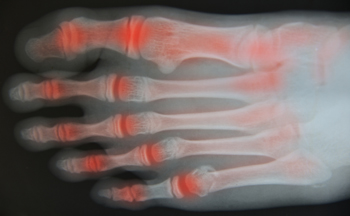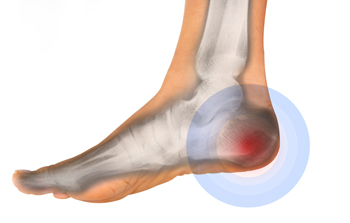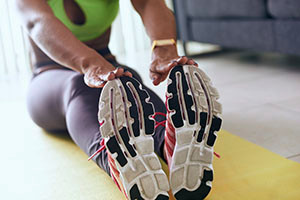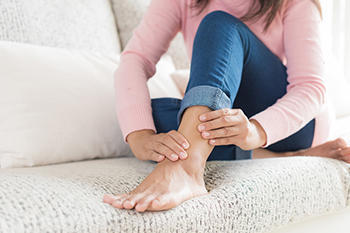Items filtered by date: May 2022
Treating Painful Symptoms of Rheumatoid Arthritis

Rheumatoid arthritis can be a debilitating disease where a joint's lining (synovium) is attacked by the body’s immune system. This causes the synovium to become inflamed, which damages the surrounding tissues and ligaments. In time, this may dislocate toe joints and cause deformities such as bunions and hammertoes. Along with toe joints, rheumatoid arthritis can also occur in the ankle joint, the tarsometatarsal joints in the midfoot, and the hindfoot (heel area). While rheumatoid arthritis has no cure, a podiatrist can help treat its symptoms which, if left untreated, may inhibit a person’s ability to lead a normal life. Your podiatrist may prescribe special shoes, braces, and/or create custom orthotics to help restore functionality to the feet and ankles and relieve pain. Icing, gentle exercises, and physical therapy may also help relieve symptoms, as can corticosteroid injections. Make an appointment with a podiatrist today to begin treatment for your painful rheumatoid arthritis symptoms.
Because RA affects more than just your joints, including the joints in your feet and ankles, it is important to seek early diagnosis from your podiatrist if you feel like the pain in your feet might be caused by RA. For more information, contact Jim Maxka, DPM of South Penn Foot & Ankle Associates. Our doctor will assist you with all of your podiatric concerns.
What Is Rheumatoid Arthritis?
Rheumatoid Arthritis (RA) is an autoimmune disorder in which the body’s own immune system attacks the membranes surrounding the joints. Inflammation of the lining and eventually the destruction of the joint’s cartilage and bone occur, causing severe pain and immobility.
Rheumatoid Arthritis of the Feet
Although RA usually attacks multiple bones and joints throughout the entire body, almost 90 percent of cases result in pain in the foot or ankle area.
Symptoms
- Swelling and pain in the feet
- Stiffness in the feet
- Pain on the ball or sole of feet
- Joint shift and deformation
Diagnosis
Quick diagnosis of RA in the feet is important so that the podiatrist can treat the area effectively. Your doctor will ask you about your medical history, occupation, and lifestyle to determine the origin of the condition. Rheumatoid Factor tests help to determine if someone is affected by the disease.
If you have any questions please feel free to contact our office located in Hanover, PA . We offer the newest diagnostic and treatment technologies for all your foot and ankle needs.
Causes of Heel Pain

When you pound your feet on hard surfaces during sports, running, or other activities, the heels take the brunt of this pressure. It’s not surprising that they will begin to hurt. The most common heel pain complaint is from plantar fasciitis, where the band of tissue that connects the heel to the toes becomes inflamed. Other heel problems include stress fractures, nerve entrapment, and heel pad syndrome, which can be the result of aging or repetitive stress. Achilles tendonitis, pain in the back of heel, occurs when a tendon that attaches the heel to the leg bone becomes inflamed, stretched or even ruptured. Other causes of heel pain include wearing shoes with poor cushioning, tight calf muscles, and sudden inward or outward turning of the feet. Landing hard on the heels, especially from a height, can also bruise or even fracture the bones. If your heel pain continues or worsens, it is best to consult with a podiatrist for a thorough examination of the area affected and appropriate treatment options.
Many people suffer from bouts of heel pain. For more information, contact Jim Maxka, DPM of South Penn Foot & Ankle Associates. Our doctor can provide the care you need to keep you pain-free and on your feet.
Causes of Heel Pain
Heel pain is often associated with plantar fasciitis. The plantar fascia is a band of tissues that extends along the bottom of the foot. A rip or tear in this ligament can cause inflammation of the tissue.
Achilles tendonitis is another cause of heel pain. Inflammation of the Achilles tendon will cause pain from fractures and muscle tearing. Lack of flexibility is also another symptom.
Heel spurs are another cause of pain. When the tissues of the plantar fascia undergo a great deal of stress, it can lead to ligament separation from the heel bone, causing heel spurs.
Why Might Heel Pain Occur?
- Wearing ill-fitting shoes
- Wearing non-supportive shoes
- Weight change
- Excessive running
Treatments
Heel pain should be treated as soon as possible for immediate results. Keeping your feet in a stress-free environment will help. If you suffer from Achilles tendonitis or plantar fasciitis, applying ice will reduce the swelling. Stretching before an exercise like running will help the muscles. Using all these tips will help make heel pain a condition of the past.
If you have any questions please contact our office located in Hanover, PA . We offer the newest diagnostic and treatment technologies for all your foot and ankle needs.
Busy Life? Make Time to Warm Up and Cool Down Before and After Running

There are many people who have busy schedules which can make it difficult to practice adequate warm up and cool down stretches before running. It is important to make time to properly stretch before and after running, as this may help to prevent running injuries. Beneficial changes that can help to avoid injuries consist of improving form by maintaining good posture, and practicing correct training procedures. Research has shown it helps to gradually increase mileage and speed, and it is important to stay hydrated and to eat enough protein. Additionally, when one day per week is taken off from running, it can help to give the body adequate time to rest. If you have questions about how running injuries can affect the feet and how to avoid them, please consult with a podiatrist.
Exercising your feet regularly with the proper foot wear is a great way to prevent injuries. If you have any concerns about your feet, contact Jim Maxka, DPM of South Penn Foot & Ankle Associates. Our doctor will treat your foot and ankle needs.
How to Prevent Running Injuries
Many common running injuries are caused by overuse and overtraining. When the back of the kneecap starts wearing out and starts causing pain in your knee, this is commonly referred to as runner’s knee. Runner’s knee is a decrease in strength in your quadriceps and can occur if you’re not wearing properly fitted or supporting shoes. To prevent runner’s knee, focusing on hip strengthening is a good idea, as well as strengthening your quads to keep the kneecaps aligned.
What Are Some Causes of Running Injuries?
- One cause of a common running injury is called iliotibial band syndrome.
- Plantar fasciitis is also another common injury.
- Stress fractures can occur from overtraining, lack of calcium, or even your running style.
Best Ways to Prevent Running Injuries
- Wear footwear that fits properly and suits your running needs.
- Running shoes are the only protective gear that runners have to safeguard them from injury.
- Make a training schedule. Adding strengthening exercises as well as regular stretching can help keep you strong and limber and can lessen the possibility of injuries.
- Stretching keeps muscles limber; this will help you gain better flexibility.
If you have any questions please feel free to contact our office located in Hanover, PA . We offer the newest diagnostic and treatment technologies for all your foot and ankle needs.
Wounds That Don't Heal Need to Be Checked
How Obesity Can Contribute to Flat Feet

Increased body weight adds stress to the feet and is thought to be a contributing factor to several foot conditions. Flat feet, or pes planus, is one of these. Arches are designed, partly, to help absorb the body’s weight while standing or moving, and also to act as shock absorbers. The heavier a person is, the harder it is for this structure to maintain its shape and do its job. The arch will become lower as it struggles under the excessive weight it is bearing, and in some cases, may completely collapse. Additionally, obesity may cause a person to angle their feet outward as they walk, with a wider-than-normal gait. These changes in stride can also make it more difficult for the arch to keep its normal shape and height. Flat feet can sometimes cause pain in the arch and/or muscles, as well as fatigue and aching in the feet and legs. Losing weight is a good step towards helping to relieve symptoms. A podiatrist can also help ease your discomfort and use a variety of techniques to support the arch and correct gait abnormalities.
Obesity has become very problematic at this point in time and can have extremely negative effects on the feet. If you’re an obese individual and are concerned about your feet, contact Jim Maxka, DPM from South Penn Foot & Ankle Associates. Our doctor can provide the care you need to keep you pain-free and on your feet.
Obesity and Your Feet
Since your feet are what support your entire weight when standing, any additional weight can result in pain and swelling. Being overweight is one of the main contributors to foot complications.
Problems & Complications
Extra Weight – Even putting on just a few extra pounds could create serious complications for your feet. As your weight increases, your balance and body will shift, creating new stresses on your feet. This uneven weight distribution can cause pain, even while doing the simplest tasks, such as walking.
Diabetes – People who are overweight are at serious risk of developing type-2 diabetes, which has a drastic impact on the health of your feet. As you get older, your diabetes might worsen, which could lead to loss of feeling in your feet, sores, and bruises. You could also become more prone to various infections.
Plantar fasciitis – Pressure and stress that is placed on muscles, joints, and tendons can trigger plantar fasciitis, which is an inflammation of tissue that forms along the bottom of the foot.
If you have any questions please feel free to contact our office located in Hanover, PA . We offer the newest diagnostic and treatment technologies for all your foot and ankle needs.
When to Use Heat or Ice to Reduce Pain

It is common for many people to reach for either an ice pack or a heating pad when they experience minor toe, foot or ankle pain. Heat and ice do frequently work to relieve discomfort, but knowing which one to use can be confusing. The first thing to know is that heat causes blood vessels to open (dilate), and ice causes them to constrict. Heat brings more blood to the injured area, helping to ease pain, spasm and stiffness. It is usually recommended for aching muscles, cramps or stiffness. A heat compress should not be overly hot, or it can burn the skin. A cloth or towel between the compress and the skin is suggested. On the other hand, it is not a good idea to use heat on a new injury, because it can add to any bleeding under the skin. Ice is more often used immediately after an injury to reduce pain, swelling and bruising, and to help numb the area. It is wise to place a cloth or towel between the ice pack and the skin and to leave the ice pack on for no longer than 30 minutes. After a severe ankle injury, especially if you think you may have torn a ligament or broken a bone, it is suggested that you visit a podiatrist immediately for examination, diagnosis and treatment.
Wound care is an important part in dealing with diabetes. If you have diabetes and a foot wound or would like more information about wound care for diabetics, consult with Jim Maxka, DPM from South Penn Foot & Ankle Associates. Our doctor will assess your condition and provide you with quality foot and ankle treatment.
What Is Wound Care?
Wound care is the practice of taking proper care of a wound. This can range from the smallest to the largest of wounds. While everyone can benefit from proper wound care, it is much more important for diabetics. Diabetics often suffer from poor blood circulation which causes wounds to heal much slower than they would in a non-diabetic.
What Is the Importance of Wound Care?
While it may not seem apparent with small ulcers on the foot, for diabetics, any size ulcer can become infected. Diabetics often also suffer from neuropathy, or nerve loss. This means they might not even feel when they have an ulcer on their foot. If the wound becomes severely infected, amputation may be necessary. Therefore, it is of the upmost importance to properly care for any and all foot wounds.
How to Care for Wounds
The best way to care for foot wounds is to prevent them. For diabetics, this means daily inspections of the feet for any signs of abnormalities or ulcers. It is also recommended to see a podiatrist several times a year for a foot inspection. If you do have an ulcer, run the wound under water to clear dirt from the wound; then apply antibiotic ointment to the wound and cover with a bandage. Bandages should be changed daily and keeping pressure off the wound is smart. It is advised to see a podiatrist, who can keep an eye on it.
If you have any questions, please feel free to contact our office located in Hanover, PA . We offer the newest diagnostic and treatment technologies for all your foot care needs.

 Like Us
Like Us Follow Us
Follow Us Review Us
Review Us